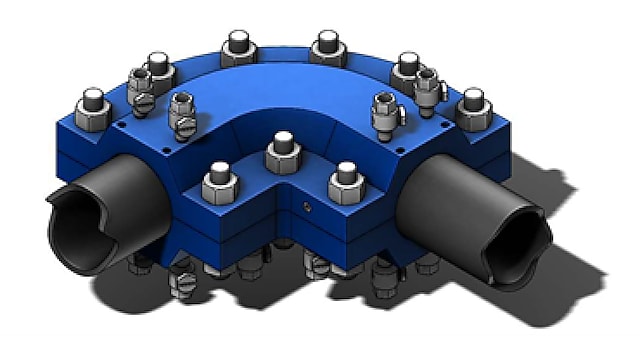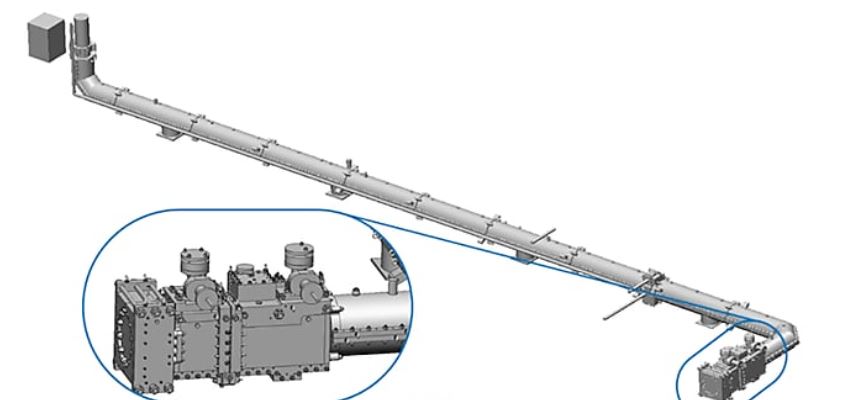Shell has successfully installed the first 3D printed leak repair clamp in service. Clamps, also known as mechanical leak repair enclosures, are engineered solutions that are used to encapsulate and restore integrity of operating pipelines against pipeline defects or wall thinning arising through erosion and corrosion mechanisms.
At present, a simple clamp can be manufactured within 3-5 days, but complex clamps may take 4 weeks or more, when factoring in delivery times from limited fabricators specialised in pressure enclosures. The ability to apply such temporary repairs is critical to enable facilities to remain on-stream. The availability of essential equipment can be maximised, thereby reducing production loss and environmental emissions. Defects can occur in diverse locations given the complexity of piping systems, often triggering the need for dedicated, customised solutions. The speed of response to restore the mechanical integrity and continuous safe operation of the asset is critical.
3D printing is an additive manufacturing technology in which the material is built up through a layer by layer deposition process. This technique is claimed to have an edge over other conventional manufacturing techniques such as casting or forging due to its ability to manufacture parts with intricate geometries. 3D printing offers the ability to produce the near net shape of the desired component, limiting the need for high material wastage during the machining process typical of current manufacturing practices.
Finally, 3D printing is transferable across product designs, as the manufacturing process only requires the use of computer-aided design of the product, and programming of the build (deposition) robot. In case of conventional techniques for large items, preparing bespoke tooling such as moulds and dies normally involves a greater lead time and costs.
Due to its merit, 3D printing technology was chosen for the fabrication of selected clamps for use in our operations. A proof of concept (POC) was executed collaboratively by Shell, TEAM, Inc. and Vallourec. Together, the team established a technical specification and inspection test plan for the first clamp with an industrial application to be produced completely with a Wire Arc Additive Manufactured (WAAM) technique. The goal was to verify the feasibility of using a WAAM technique to produce clamps for leak repair which will meet the required quality assurance for medium-pressure steam systems. The proof of concept helped gather insights into the steps needed to improve the quality and productivity for future applications.

What did we learn?
- The 3D printed clamp successfully passed the burst test conducted at 142.4 bar (over 5 times that of the intended design pressure). This satisfies the appropriate level of technical readiness within Shell to qualify the part for a field application.
- In this case, the overall delivery lead time was longer than for a conventionally manufactured clamp as it was the first product. This is because it falls under the highest criticality category under the DNV B203 standard for Additive manufacturing of metallic parts*. Three sets of clamps were produced for extensive testing even though only one set was eventually installed. As it was a first of its kind demonstration project, the team focussed more on designing the clamp for a 100% success rate in inspection rather than on design optimisation. This increased lead time and costs was a design choice for the POC.
- The project involved shipment of the parts for printing and testing at different locations and countries, which contributed to the increased lead time and costs. This speaks in favour of our vision of integrated additive manufacturing ecosystems nearby operations.
- The different steps involved in procurement process as well as quality assurance and quality control account for more than 50% of the time required for the POC.
What is coming next?
The next phase will focus on ensuring the product quality and consistency, as well as reducing the lead time and costs for the additive manufacturing of selected clamps by streamlining the qualification process and reducing the need for duplicable parts. It is intended that the future projects will enable the following:
- the formation of a database with all inspection and qualification test results reflecting the quality variance in WAAM parts. Analysing this data can help reduce the criticality classification of the 3D printed spare parts or the among of non-destructive testing required prior to using the parts in production.
- the development of application specific qualification requirements, allowing more complex parts to be qualified based on case history and successful in-service use cases of simpler parts; and
- the creation a library of qualified configurations to reduce qualification efforts of same or similar products in future.
Collaboration is key to reduce lead time and costs
Activities to create extensive data sets about 3D printing spare parts are resource intensive. We achieve greater knowledge faster by collaborating with interested end users who have similar needs. Process standardisation of WAAM technology, specifically in quality control, is paramount to improve lead time and reduce costs. Shell believes that a great leap for the adoption of 3D printing technology in the energy sector can come from such a standardisation across the industry.
Subscribe to AM Chronicle Newsletter to stay connected: https://bit.ly/3fBZ1mP
Follow us on LinkedIn: https://bit.ly/3IjhrFq
Visit for more interesting content on additive manufacturing: https://amchronicle.com




